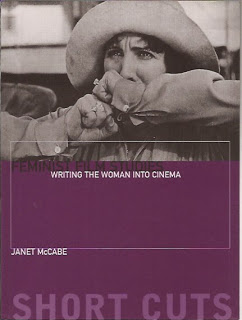Leading comedic roles for women in film and television are often relegated to “romantic” comedy and these women still, in 2011, struggle to break into the classification of comedy–without modifiers–and remain relegated to the dreaded “chick flick” (a term that the title of this website plays off of).
From the section “Romantic comedy and gender” in the book Feminist Film Studies: Writing the Woman into Cinema .
.
Television comedy is another area of recent feminist inquiry, which investigates in particular star performance, joke-making techniques and the television audience. Alexander Doty (1990), investigating the interplay between the star image of Lucille Ball and the character she plays in I Love Lucy (Desilu Productions Inc/CBS, 1951-57) argues that Lucy Ricardo is constructed as the zany, loveable, ditzy and talentless housewife and mother based on the denial, repression and (re)construction of Ball’s star image. Patricia Mellencamp (1997) is another scholar fascinated by Lucille Ball’s slapstick routines. Recuperating Ball’s performance as an act of defiance from the confinement of the domestic space allows her to locate the radical underpinnings of the show for female viewers. Each week Lucy unsuccessfully attempting to escape domesticity and break into show business. They physical comic routines performed by Ball offered a means of challenging patriarchy as she upstages her husband/other men; and this is what audiences tuned in to see. Drawing on Freud’s theory of humorous pleasures (that is, humour used to avoid emotional pain) enables Mellencamp to argue that laughter directed at Lucy’s performance of being talentless – ‘her wretched, off-key singing, her mugging facial exaggerations and out-of-step dancing [is] paradoxically both the source of the audience’s pleasure and the narrative necessity for housewifery’ (1997: 73). She contends that Lucy’s situation made visible the real dilemmas faced by many women: ‘Given the repressive conditions of the 1950s, humour might have been women’s weapon and tactic of survival, ensuring sanity, the triumph of the ego, and pleasures’ (ibid).
One of the most sustained discussions on gender, representation and cross-cultural theories is Kathleen Rowe’s study of the unruly woman (1995). Using theoretical models from Mikhail Bakhtin concerned with the grotesque, Rowe identifies the grotesque body as ultimately the female body – often an outrageous, voluptuous, loud, joke-cracking dissenter or ‘woman on top’. The unruly female is not about gender confusion but inverting dominant social, cultural and political conventions; unruliness occurs when those who are socially or politically inferior (normally, women) use humour and excess to undermine patriarchal norms and authority. Focusing on Roseanne Arnold allows her to suggest how Roseanne’s star image and her television situation (Carsey-Werner Company/ABC, 1988-1997) disrupt and expose the gap between feminist liberation (informed by second-wave feminism) and the realities of working-class family life (those of whom feminist liberation left behind), between ideals of true womanhood and unruliness to challenge notions of a patriarchal construction of femininity. Making a spectacle of herself – her overweight body, her physical excesses, her performance as loud and brash – reveals ambivalence as the unruly woman speaks out. Difficulties faced by Roseanne in the press with the vitriol directed at her ‘make known the problems of representing what in our culture still remains largely unrepresentable: a fat woman who is also sexual; a sloppy housewife who’s a good mother; a “loose” woman who is also tidy, who hates matrimony but loves her husband, who hates the ideology of true womanhood, yet considers herself a domestic goddess’ (1995:91).
As I hope is clear, feminist critics disclose how television culture is informed by context and given meaning through the ways in which particular programmes are consumed, how narratives are experienced and what they mean to the female viewer – what television series says about women and how media texts function in their daily lives. Through interviews, Deborah Jermyn (2003) analyses how women talk about the series in an effort to understand what Sex and the City (HBO, 1998-2004) means to female fans. Pivotal here is the point at which Jermyn’s own fandom intersects with the experience of those she interviewed – it is a moment that allows her to reveal both the pleasures and difficulties involved in understanding how fan culture operates and how to speak about it.
I Love Lucy and
Roseanne are two shows that were able to reach a large mainstream audience, while
Sex and the City remained, most definitely, for female audiences (as has
the atrocious film franchise). Yet
Sex and the City is very different from these two other shows, in that it is (for the most part) about women who
aren’t in these traditional domestic roles.
What leading women of comedy since the 90s reach across gender divides and avoid the ghettoization of the “chick flick?” Who are the new “unruly” women? Does Tyler Perry’s Madea count? (I’m only half joking here.) I’d love to hear readers’ thoughts on these matters.

